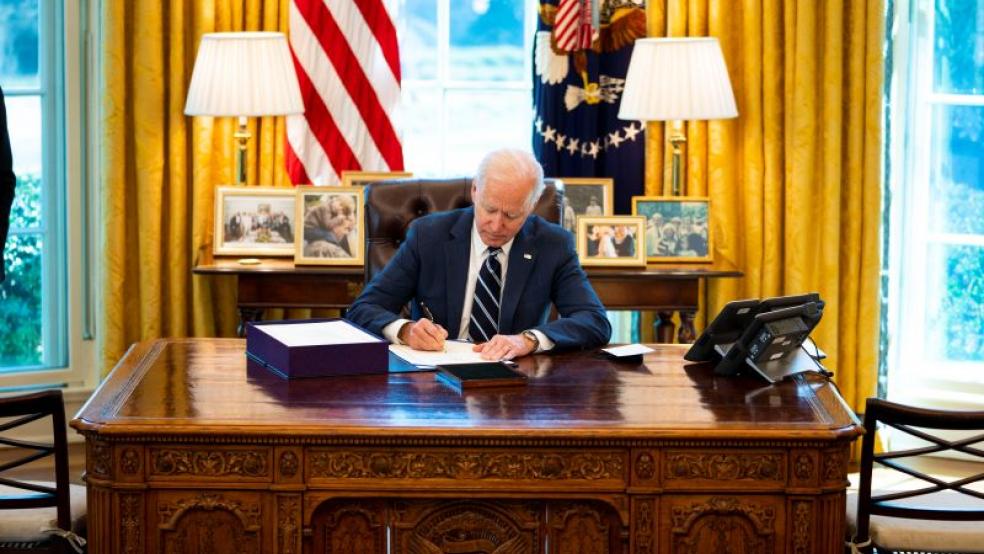President Biden signed the American Rescue Plan Act into law one year ago today, pushing $1.9 trillion of relief spending and economic stimulus into the U.S. economy in response to the Covid-19 pandemic.
Biden marked the anniversary at a policy retreat Friday. “Few pieces of legislation – no hyperbole – in American history have done more to lift this country out of a crisis than what you did,” Biden told lawmakers assembled at the House Democratic Caucus Issues Conference in Philadelphia. “We did it alone, without one single solitary Republican vote,” he added. “The American economy was flat on its back. It was the Democrats – it was you – that brought us back.”
Retiring House Budget Chairman John Yarmuth (D-KY) also commented on the spending package. “Spearheading this transformative and historic legislation as Chairman of the Budget Committee will remain a highlight of my time here in Congress,” he said. “This law saved lives and changed the course of the pandemic and our economic recovery. Because of the American Rescue Plan, we were able to help families stay in their homes and feed their children, help small businesses keep their doors open, ensure communities were not left behind in the recovery, and lay the groundwork for the record-breaking recovery we are experiencing now.”
Like many Democrats, Yarmuth credited the law with helping to sharply reduce the unemployment rate while adding 7 million jobs in 2021, and with driving growth rates to multi-decade highs. “Make no mistake – this growth was not inevitable,” he said. “Before the American Rescue Plan, our recovery was not projected to reach many these milestones until at least 2024. Clearly, we have made tremendous progress in a short period of time.”
A quick look back: The sprawling relief package funded a wide array of programs aimed at every part of the U.S. economy. Another round of direct stimulus payments was included, worth up to $1,400 per person, and additional subsidies for insurance costs helped millions of people keep their health coverage. Enhanced unemployment payments were extended through the end of the summer, providing an extra $300 a week for people who lost their jobs. The child tax credit was expanded, providing direct payments worth as much as $3,600 for younger children, and the earned income tax credit was made more widely available. Schools received $130 billion to help defray the costs of the pandemic, while businesses received over $30 billion to help keep their doors open. About $15 billion went toward Covid-19 testing, while another $15 billion was designated for vaccine development and distribution. And state and local governments received $350 billion, with few strings attached.
A complicated legacy: Most analysts agree that the legislation provided a powerful boost to an economy still feeling the effects of the pandemic, but serious questions remain about whether the spending package was too big.
White House adviser Gene Sperling said the economy is far stronger today thanks to the legislation. “Looking at how resilient and equitable the recovery has been in the face of delta, omicron and now military conflict in Europe, that strategy already looks wise,” he told the Associated Press.
But Jason Furman, who led the Council of Economic Advisers in the Obama administration, said the spending package may have backfired by contributing to the current inflationary spiral, souring some lawmakers on the prospects of turning temporary social programs like the enhanced child tax credit into permanent ones, and adding to the challenges of creating many of the new programs that Biden has sought.
“The gamble was it would create a success that would make people want to do more,” Furman said. “But it contributed to inflation that made people want to do less. In some ways, that’s the biggest consequence. It was a gamble, and they lost that gamble, and it hurt.”
How much inflation? Economists continue to debate just how much the ARP contributed to inflation, which hit 7.9% in February on an annual basis, the biggest increase in consumer prices in 40 years.
On Friday, Biden tied the latest inflation numbers to Covid-driven supply chain issues and the Russian invasion in Ukraine. “Democrats didn’t cause this problem. Vladimir Putin did. Putin’s gas tax has pushed prices higher,” Biden said.
But while Russian aggression is no doubt contributing to soaring energy costs worldwide, the broader inflationary trend was well-established before Putin made his move on Ukraine. The question is, how much did the ARP contribute to that trend?
An analysis published by the Federal Reserve Bank of San Francisco last fall argued that the pandemic spending package did indeed contribute to inflation, but at a modest rate of just three-tenths of a percentage point. More recently, Furman estimated that ARP increased inflation by about 2.5 percentage points. Michael Strain, an economist at the conservative American Enterprise Institute, argues for a more substantial effect of 3 percentage points. Notably, none of the estimates find that the spending accounts for even half of the inflation in the economy, though all agree that there has been some kind of effect from the legislation while leaving room for other factors to be in play.
Politically, the analysis tends to be less subtle, with Republicans arguing that virtually all of the inflation we’re seeing today is a result of what they call excess government spending. On the other side of the aisle, some Democrats have attempted to pin the blame on corporate greed and a long-term lack of investment in the supply side of the economy.
The bottom line: Democrats’ $1.9 trillion pandemic response bill leaves a mixed legacy: faster growth and higher inflation at the same time. The ultimate assessment depends on whether you think it was worth risking more inflation to strengthen what has proved to be a robust — though now troubled —economic recovery.




